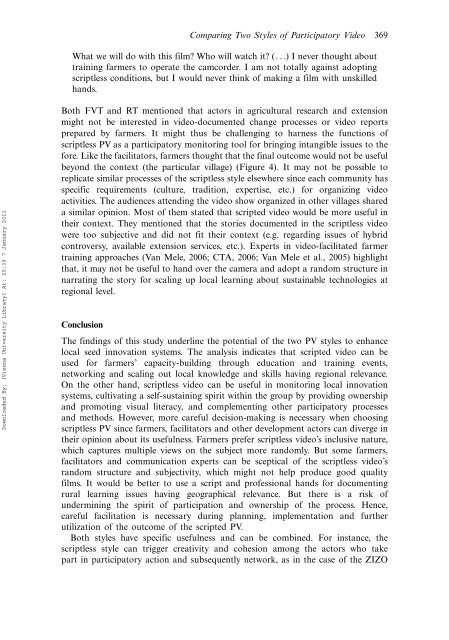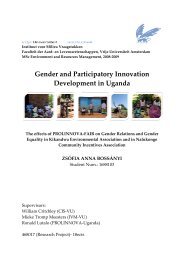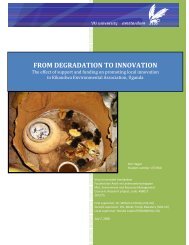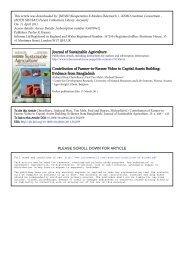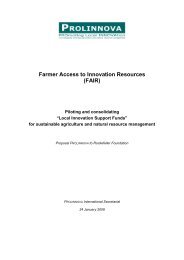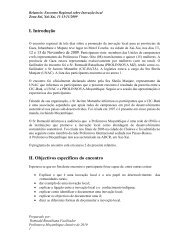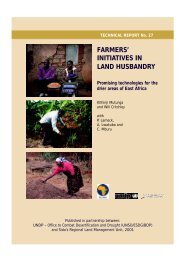Chowdhury et al (2010); PDF file - Prolinnova
Chowdhury et al (2010); PDF file - Prolinnova
Chowdhury et al (2010); PDF file - Prolinnova
Create successful ePaper yourself
Turn your PDF publications into a flip-book with our unique Google optimized e-Paper software.
Comparing Two Styles of Participatory Video 369<br />
What we will do with this film? Who will watch it? (...) I never thought about<br />
training farmers to operate the camcorder. I am not tot<strong>al</strong>ly against adopting<br />
scriptless conditions, but I would never think of making a film with unskilled<br />
hands.<br />
Downloaded By: [Vienna University Library] At: 20:39 7 January 2011<br />
Both FVT and RT mentioned that actors in agricultur<strong>al</strong> research and extension<br />
might not be interested in video-documented change processes or video reports<br />
prepared by farmers. It might thus be ch<strong>al</strong>lenging to harness the functions of<br />
scriptless PV as a participatory monitoring tool for bringing intangible issues to the<br />
fore. Like the facilitators, farmers thought that the fin<strong>al</strong> outcome would not be useful<br />
beyond the context (the particular village) (Figure 4). It may not be possible to<br />
replicate similar processes of the scriptless style elsewhere since each community has<br />
specific requirements (culture, tradition, expertise, <strong>et</strong>c.) for organizing video<br />
activities. The audiences attending the video show organized in other villages shared<br />
a similar opinion. Most of them stated that scripted video would be more useful in<br />
their context. They mentioned that the stories documented in the scriptless video<br />
were too subjective and did not fit their context (e.g. regarding issues of hybrid<br />
controversy, available extension services, <strong>et</strong>c.). Experts in video-facilitated farmer<br />
training approaches (Van Mele, 2006; CTA, 2006; Van Mele <strong>et</strong> <strong>al</strong>., 2005) highlight<br />
that, it may not be useful to hand over the camera and adopt a random structure in<br />
narrating the story for sc<strong>al</strong>ing up loc<strong>al</strong> learning about sustainable technologies at<br />
region<strong>al</strong> level.<br />
Conclusion<br />
The findings of this study underline the potenti<strong>al</strong> of the two PV styles to enhance<br />
loc<strong>al</strong> seed innovation systems. The an<strong>al</strong>ysis indicates that scripted video can be<br />
used for farmers’ capacity-building through education and training events,<br />
n<strong>et</strong>working and sc<strong>al</strong>ing out loc<strong>al</strong> knowledge and skills having region<strong>al</strong> relevance.<br />
On the other hand, scriptless video can be useful in monitoring loc<strong>al</strong> innovation<br />
systems, cultivating a self-sustaining spirit within the group by providing ownership<br />
and promoting visu<strong>al</strong> literacy, and complementing other participatory processes<br />
and m<strong>et</strong>hods. However, more careful decision-making is necessary when choosing<br />
scriptless PV since farmers, facilitators and other development actors can diverge in<br />
their opinion about its usefulness. Farmers prefer scriptless video’s inclusive nature,<br />
which captures multiple views on the subject more randomly. But some farmers,<br />
facilitators and communication experts can be sceptic<strong>al</strong> of the scriptless video’s<br />
random structure and subjectivity, which might not help produce good qu<strong>al</strong>ity<br />
films. It would be b<strong>et</strong>ter to use a script and profession<strong>al</strong> hands for documenting<br />
rur<strong>al</strong> learning issues having geographic<strong>al</strong> relevance. But there is a risk of<br />
undermining the spirit of participation and ownership of the process. Hence,<br />
careful facilitation is necessary during planning, implementation and further<br />
utilization of the outcome of the scripted PV.<br />
Both styles have specific usefulness and can be combined. For instance, the<br />
scriptless style can trigger creativity and cohesion among the actors who take<br />
part in participatory action and subsequently n<strong>et</strong>work, as in the case of the ZIZO


